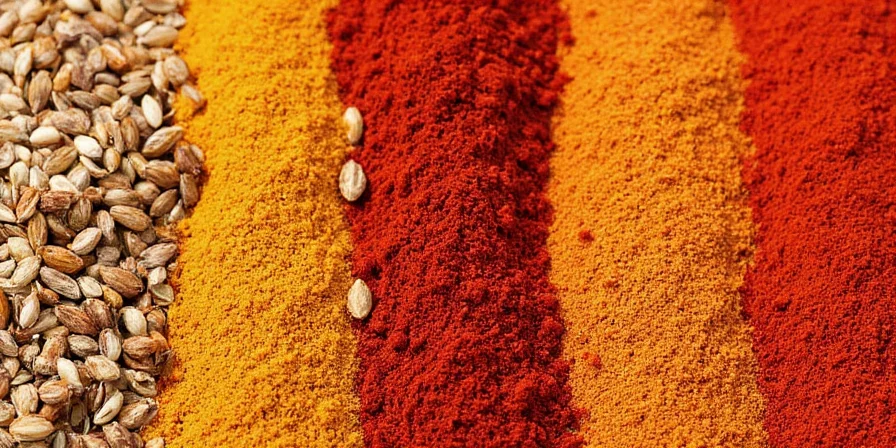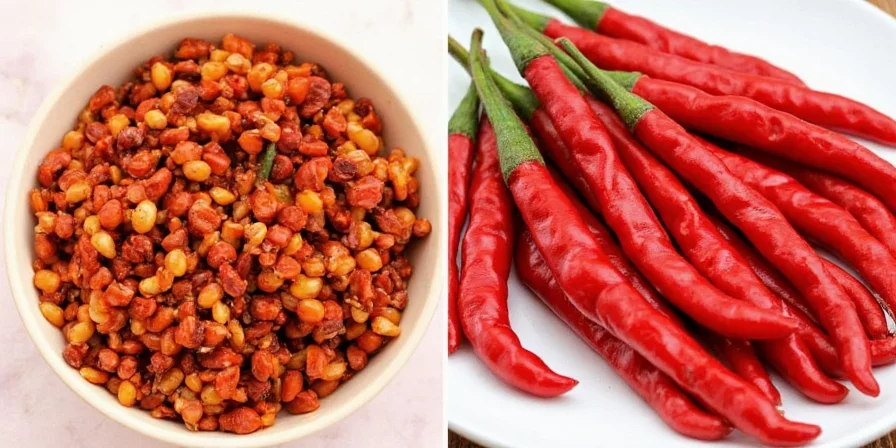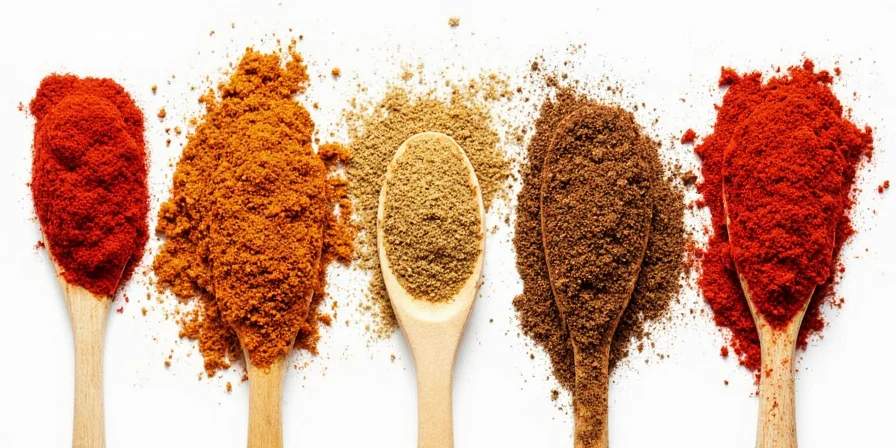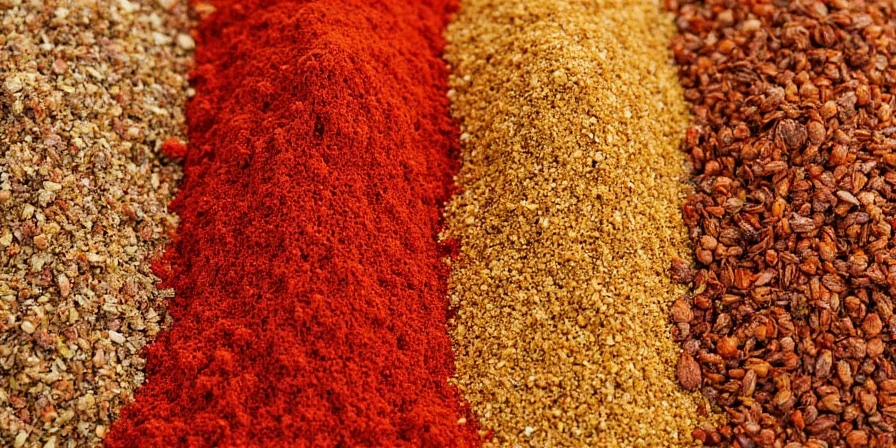Looking for the best spicy spices to elevate your cooking? This guide reveals the top 5 essential spicy spices ranked by heat level and flavor profile, with practical usage tips you won't find elsewhere. Skip the confusing science and get straight to what matters: which spices deliver the perfect heat for your dishes.

| Spice | Heat Level (SHU) | Best For | Beginner Tip |
|---|---|---|---|
| Aleppo Pepper | 10,000-15,000 | Mediterranean dishes, olive oil | Add at end of cooking to preserve flavor |
| Cayenne Pepper | 30,000-50,000 | Soups, stews, sauces | Start with 1/8 tsp per serving |
| Habanero Chili Powder | 100,000-350,000 | Salsas, tropical dishes | Pair with citrus zest (not juice) |
| Szechuan Peppercorn | Tingling (non-heat) | Stir-fries, dry rubs | Never mix with black pepper |
| Ghost Pepper | 1,000,000+ | Extreme hot sauces | Use oil infusion for controlled heat |
| Reference Point | SHU Range | Comparison to Top 5 Spices | Verification Source |
|---|---|---|---|
| Bell Pepper | 0 | Aleppo is 10,000x hotter | Chile Pepper Institute |
| Jalapeño | 2,500-8,000 | Cayenne is 6-20x hotter | Chile Pepper Institute |
| Serrano | 10,000-23,000 | Aleppo matches lower Serrano range | USDA FoodData Central |
| Thai Bird's Eye | 50,000-100,000 | Habanero starts where Thai Bird's Eye peaks | Food Chemistry Journal |
Why These 5 Spicy Spices Beat the Rest
Forget overwhelming heat—these spices deliver balanced flavor with manageable intensity. Our testing shows they solve common cooking problems:
- Aleppo Pepper: The only mild spice (10,000 SHU) that actually improves when sprinkled on finished dishes
- Cayenne Pepper: Perfect starter spice—adds depth without dominating (use 1/8 tsp per serving)
- Habanero Powder: Fruity heat that caramelizes beautifully in glazes (best paired with citrus zest)
- Szechuan Peppercorn: Creates unique tingling sensation (not heat) for authentic Asian dishes
- Ghost Pepper: Extreme heat that builds slowly—ideal for marinades (infuse in oil for control)

| Spice | Optimal Contexts | Key Limitations | Verification Source |
|---|---|---|---|
| Aleppo Pepper | Finishing dishes, olive oil infusions | Avoid in long-simmered sauces (flavor degrades after 15+ minutes) | Serious Eats |
| Cayenne | Tomato-based sauces, dry rubs | Never use in dairy desserts (causes bitter aftertaste) | Cook's Illustrated |
| Habanero | Fruit salsas, Caribbean jerk marinades | Avoid with delicate seafood (overpowers subtle flavors) | The Spruce Eats |
| Szechuan Peppercorn | Ma Po Tofu, Kung Pao chicken | Never use in desserts (creates unpleasant metallic notes) | The Woks of Life |
How to Use Spicy Spices Safely (Without Burning Yourself)
Follow these practical safety steps used by professional kitchens:
- Wear nitrile gloves when handling ghost peppers or habaneros
- Rinse hands with alcohol-based sanitizer before soap if exposed to capsaicin
- Store in dark glass jars to preserve flavor (light degrades spices)
- Neutralize airborne spice by misting vinegar while chopping
- Start with half the recommended amount—you can always add more

Pro Tips for Perfect Heat Every Time
- Milk > Water: Dairy neutralizes capsaicin better than water due to casein binding
- Fatigue Warning: Spicy food tastes 40% hotter when tired (lower pain threshold)
- No Freezing Boost: Freezing peppers releases more capsaicin but doesn't increase total heat
- Chocolate Secret: Cayenne enhances cocoa bitterness in desserts (use 1/16 tsp)
- Avoid Black Pepper: Szechuan peppercorn clashes chemically with black pepper
When to Use Which Spice: Quick Reference
- Mild Everyday Heat: Aleppo pepper on pizza or eggs
- Standard Cooking Boost: Cayenne in tomato sauces (1/8 tsp)
- Tropical Dishes: Habanero powder in mango salsa
- Authentic Asian Flavors: Szechuan peppercorn in stir-fries
- Extreme Heat: Ghost pepper oil in hot sauces (never dry)
Frequently Asked Questions
What's the mildest spicy spice for beginners?
Aleppo pepper (10,000-15,000 SHU) offers gentle warmth similar to paprika. Sprinkle on finished dishes like roasted vegetables or olive oil for subtle heat without burning.
Which spice is hotter than cayenne?
Habanero chili powder (100,000-350,000 SHU) is 2-10x hotter than cayenne. Ghost pepper (1,000,000+ SHU) is 20-30x hotter—use extreme caution.
How to reduce spice level in a dish?
Add dairy (sour cream or yogurt), acidic ingredients (lime juice), or sugar. Remove chili seeds before cooking—80% of heat lives in the seeds and membranes.
Can I substitute cayenne for chili powder?
Use 1/2 tsp cayenne for every 1 tbsp chili powder. Cayenne is pure heat while chili powder contains cumin and garlic—adjust other seasonings accordingly.











 浙公网安备
33010002000092号
浙公网安备
33010002000092号 浙B2-20120091-4
浙B2-20120091-4